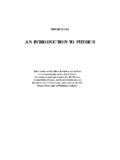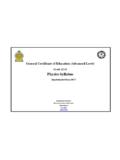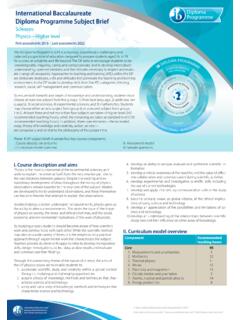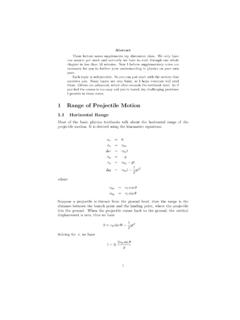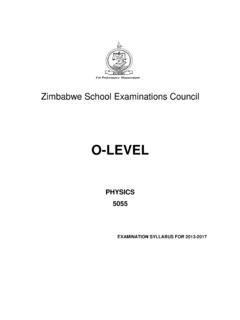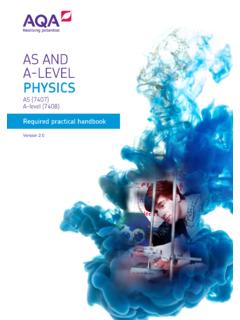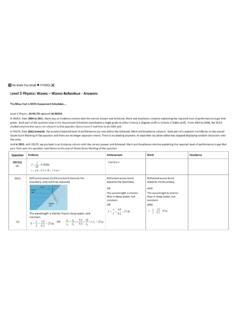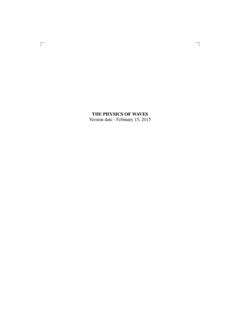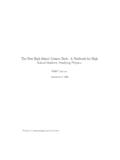Transcription of 1.2 ERRORS AND UNCERTAINTIES Notes - IB Physics at SAS - …
1 1 ERRORS AND UNCERTAINTIES Notes I. UNCERTAINTY AND ERROR IN MEASUREMENT Physics is an experimental science. All physical laws, theories, and formulae were developed based on measurements of things. All measurements in science suffer from uncertainty which results from unavoidable ERRORS . No matter how hard we try to control things, some level of experimental error is unavoidable. A source of error may be one of a number of things, or any number of those things. No measuring instrument is perfect! Reporting experimental results with appropriate uncertainty and following these through in calculations is a critical part of IB Physics . CRUCIAL THINGS TO KNOW: An error is the difference between the measured value and the expected value of something (unavoidable). An uncertainty is a way of expressing or summarizing the error (unavoidable).
2 A mistake is simply not doing something correctly through carelessness (avoidable). Thus, an error is not the same as an uncertainty, though both are unavoidable. They are often used in common language to mean the same thing, but they are not! Our strategy in dealing with UNCERTAINTIES and ERRORS is to minimize them, but at the same time be honest about them by reporting them truthfully. You will never lose marks by quoting a large final uncertainty if your procedure and method of collecting data are correct and justified, and all sources of error discussed. When we make a measurement, we generally assume that some exact or true value exists based on how we define what is being measured. While we may never know this true value exactly, we attempt to find this ideal quantity to the best of our ability with the time and resources available.
3 A. PRECISION AND ACCURACY Accuracy is the closeness of agreement between a measured value and a true or accepted value (measurement error reveals the amount of inaccuracy). Precision is a measure of the degree of consistency and agreement among independent measurements of the same quantity (also the reliability or reproducibility of the result). I. UNCERTAINTY AND ERROR IN MEASUREMENT A. PRECISION AND ACCURACY B. RANDOM AND SYSTEMATIC ERRORS C. REPORTING A SINGLE MEASUREMENT D. REPORTING YOUR BEST ESTIMATE OF A MEASUREMENT II. UNCERTAINTY IN CALCULATED RESULTS A. ABSOLUTE AND PERCENTAGE UNCERTAINTIES B. DETERMINING FINAL UNCERTAINTIES IN STATED RESULTS III. UNCERTAINTIES IN GRAPHS A. BEST FIT LINES AND ERROR BARS B. INTERPRETING LINEAR DATA C. WHAT TO DO WITH MAX AND MIN LINES 2 Think of it while you are playing darts, like this: Precision is really about detail.
4 It has nothing to do with accuracy. Accuracy is about giving true readings, not detailed readings. Imagine that you have many measured values of the same thing. If you and your instruments were perfect, every single measurement would be exactly the same. But in reality, you end up with a normal distribution of data. The area under the curve between any two measured values gives the number of measurements in that range of values. An ammeter has a zero offset error. This fault will affect A. neither the precision nor the accuracy of the readings. B. only the precision of the readings. C. only the accuracy of the readings. D. both the precision and the accuracy of the readings. The reading of a constant potential difference is made four times by a student. The readings are V, V, V, V The student averages these readings but does not take into account the zero error on the voltmeter.
5 The average measurement of the potential difference is A. precise and accurate. B. precise but not accurate. C. accurate but not precise. D. not accurate and not precise. NOT ACCURATE NOT PRECISE ACCURATE NOT PRECISE NOT ACCURATE PRECISE ACCURATE PRECISE Measured Value Number of Measurements High accuracy, low precision Low accuracy, high precision 3 B. RANDOM AND SYSTEMATIC ERRORS There are 2 types of ERRORS in measured data. It is important to understand which you are dealing with, and how to handle them. RANDOM ERRORS refer to random fluctuations in the measured data due to: o The readability of the instrument o The effects of something changing in the surroundings between measurements o The observer being less than perfect Random ERRORS can be reduced by averaging. A precise experiment has small random error.
6 SYSTEMATIC ERRORS refer to reproducible fluctuations consistently in the same direction due to: o An instrument being wrongly calibrated o An instrument with zero error (it does not read zero when it should to correct for this, the value should be subtracted from every reading) o The observer being less than perfect in the same way during each measurement. Systematic ERRORS cannot be detected or reduced by taking more measurements. An accurate experiment has small systematic error. When graphing experimental data, you can see immediately if you are dealing with random or systematic ERRORS (if you can compare with theoretical or expected results). C. REPORTING A SINGLE MEASUREMENT You would be surprised at how few people actually know how to take a proper reading of something. Most people try to report a measured value with a degree of certainty that is too generous expressing more certainty in a reported value than really exists.
7 You should avoid this! It is bad practice. Generally we report the measured value of something with the decimal place or precision going not beyond the smallest graduation (called the least count ) on the instrument. In cases where the least counts are wide enough to estimate beyond them with certainty, you may do so. It is ultimately up to the experimenter to determine how to report a measured value, but be conservative and do not overestimate the precision of the instrument. Sometimes you hear that UNCERTAINTIES should generally be reported as the least count; this is technically correct. But since they should be reported with the same # of decimal places as the instrument, in practice this amounts to stating them as the least count. Both random and systematic ERRORS are present in the measurement of a particular quantity.
8 What changes, if any, would repeated measurements of this quantity have on the random and systematic ERRORS ? Random Systematic A. reduced reduced B. reduced unchanged C. unchanged reduced D. unchanged unchanged 4 Instrument UNCERTAINTIES should be stated as the least count, and match the # of decimal places of the reported measurement. They should also have only one significant figure if possible. If the number of decimal places in your uncertainty does not match the measurement, round your uncertainty up so that it does. In most cases, you do this anyway only when you are reporting a value beyond the least count would you not do this. Decimal UNCERTAINTIES always have 1 significant figure. Measurement = measured value uncertainty (unit of measurement) For example, with a vertical meterstick (with 1 mm as the least count), you might measure the height of a chair as cm.
9 You should report the value as cm. There are some exceptions: USING STANDARD MASSES (mass) So-called standard masses are less accurate than you would think, and vary considerably. Generally consider the uncertainty to be 1%. So, 100 g = 100 1 g, kg = 1000 10 g, etc. USING STOPWATCHES (time) Most stopwatches report to the s. However, taking this least count as the uncertainty is ridiculous since you could never, ever move your thumb that fast! A more realistic uncertainty, which should be used for all time measurements with stopwatches, is s. In reality, the uncertainty in timing with a stopwatch is asymmetric but we ll simplify things and always use this value. Unfortunately, there is no general rule for determining the uncertainty in all measurements. The experimenter is the one who can best evaluate and quantify the uncertainty of a measurement based on all the possible factors that affect the result.
10 Therefore, the person making the measurement has the obligation to make the best judgment possible and report the uncertainty in a way that clearly explains what the uncertainty represents. D. REPORTING YOUR BEST ESTIMATE OF A MEASUREMENT The best way to come up with a good measurement of something is to take several measurements and average them all together. Each individual measurement has uncertainty, but the reported uncertainty in your average value is different than the uncertainty in your instrument. You do not use the instrument uncertainty in your final stated uncertainty the precision of the instrument is not the same as the uncertainty in the measurement. If you take several measurements of something, you will get a range of values. The real value should be within this range, and the uncertainty is determined by dividing the range of values by two.
